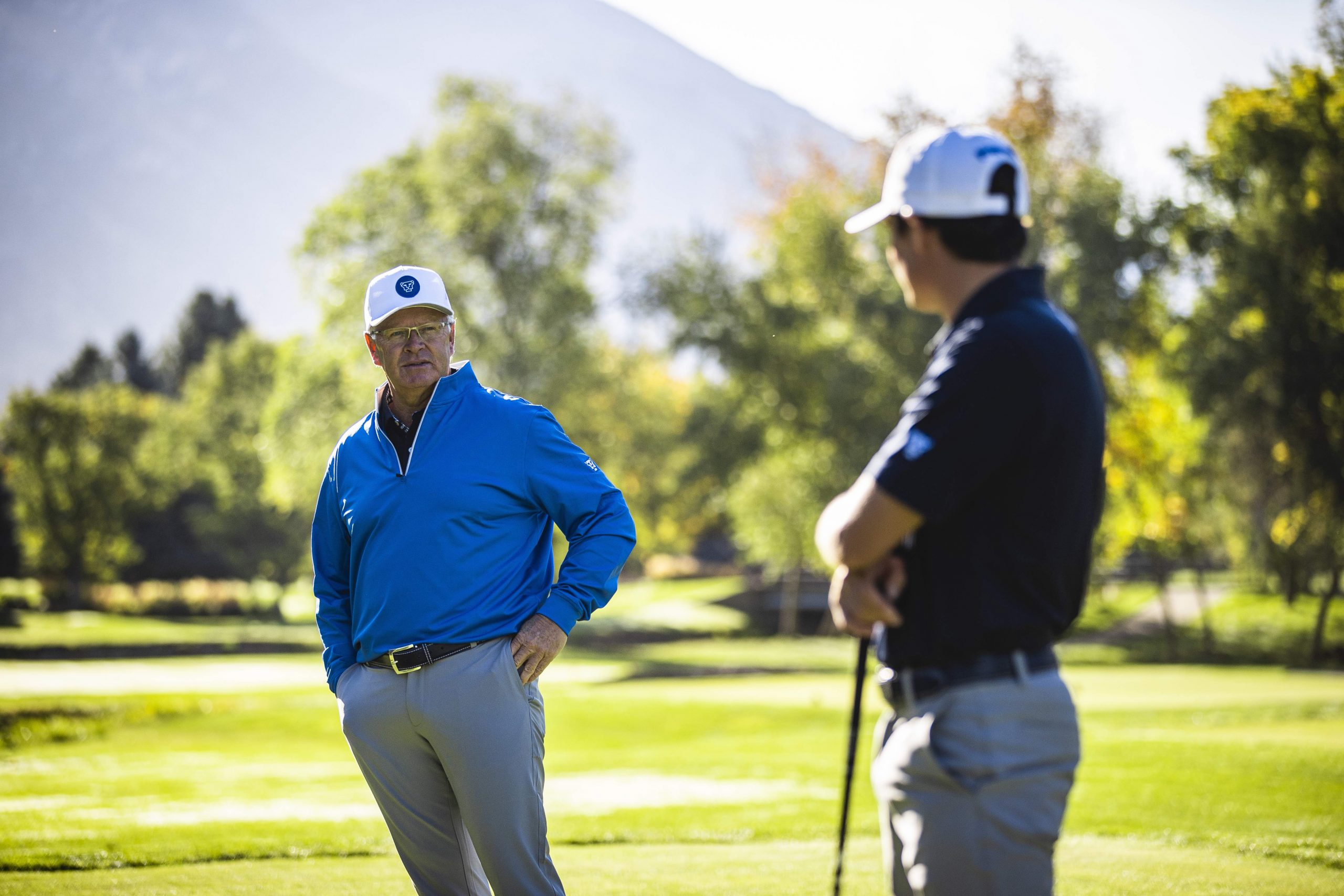Guy Yocom covered a State Amateur final match between Eric Hogg and Doug Bybee. Bruce Brockbank also won a State Am match vs. Bybee. Randy Dodson’s magazine chronicled Bybee’s becoming the only three-time champion of the past 65 years. Garey Chadwick and Sherm Hatfield were Utah Golf Association board members and rules officials for nearly those players’ entire careers.
The Utah Golf Hall of Fame’s seven-member Class of 2024 is intertwined like no other group in the Hall’s history that dates to 1991. The 10th ceremony, planned for October, will increase the membership to 55. That number makes the Utah Golf Hall of Fame the most exclusive sports club in the state, considering that competitive golf has been played in Utah for 125 years.
The previous class was honored in 2021, after a one-year delay due to the pandemic. The next inductions are planned in 2028, resuming the every-four-years pattern.
BRUCE BROCKBANK JR.
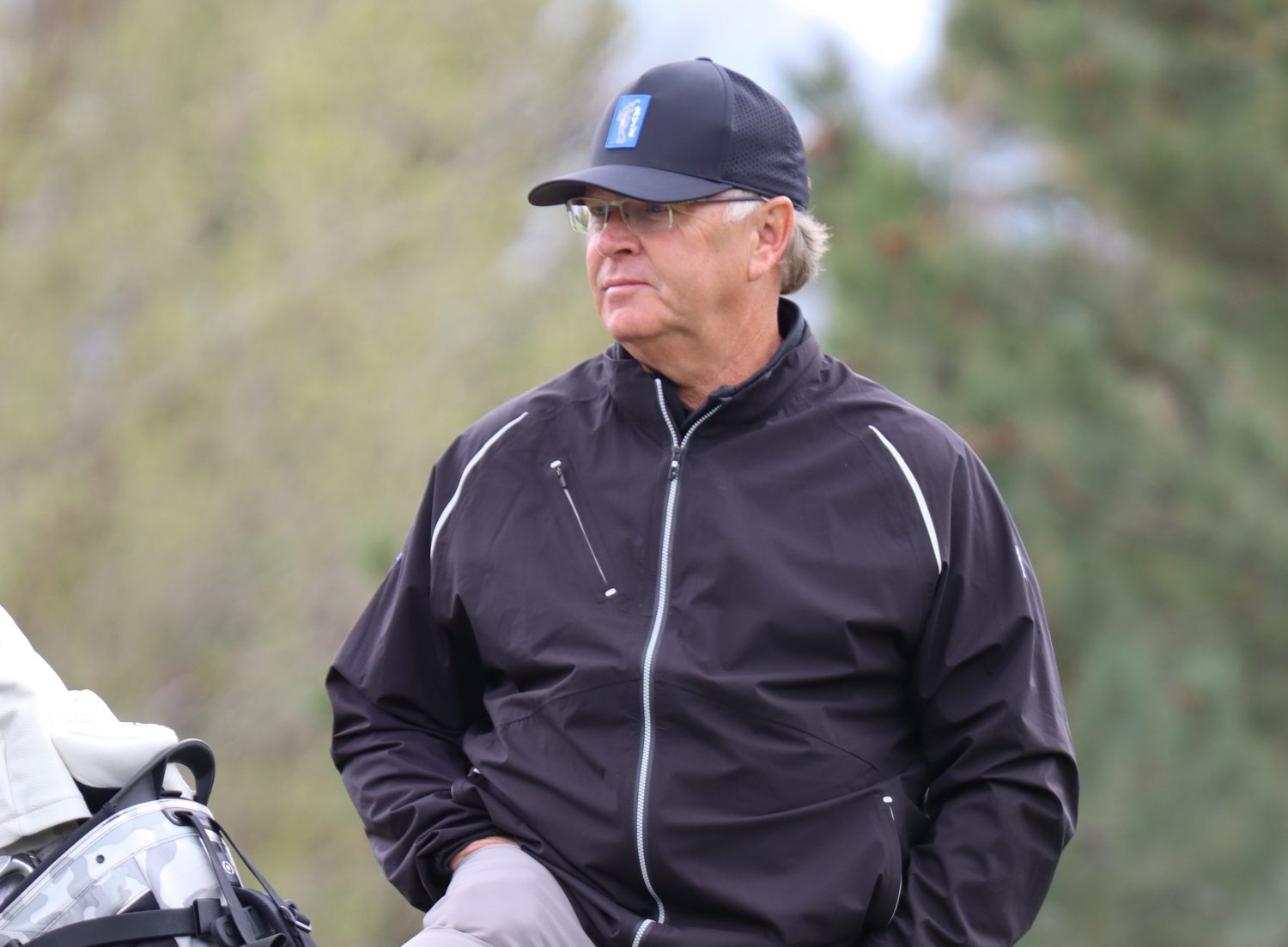
Two head coaches, 63 years, two Utah Golf Hall of Fame inductions.
That’s the modern history of the Brigham Young University men’s golf program. Linking the late Karl Tucker and Bruce Brockbank is only natural, after Brockbank played for the Cougars, assisted Tucker and followed him as head coach. As of the 2023-24 season, Brockbank’s 32-year tenure topped Tucker’s 31 years on the job.
Brockbank grew up around Riverside Country Club in the 1970s and early ‘80s, modeling the swing and demeanor of BYU golfers such as Utah Golf Hall of Fame member Mike Reid. And then he was inspired by future Cougar teammate Steve Schneiter’s 1982 State Amateur victory, driving him to win two titles of his own. Fittingly, Schneiter is a member of the Utah Golf Hall of Fame class that preceded Brockbank’s.
The late Bruce Brockbank Sr. loved having BYU golfers visit the family’s home, creating good influences for his three sons and daughter, Stephanie, a two-time Women’s State Amateur champion. Counting those childhood days, Bruce Jr. has been associated with practically every BYU golfer of the past 50 years.
Brockbank’s playing credentials alone would have merited Utah Golf Hall of Fame consideration. He led Timpview High School to three state championships and, just before turning professional, won consecutive State Amateur titles. He compiled a 19-4 record in State Am match play, while twice finishing second. In 1987, the Utah Section PGA named him the Wesley Ruff Golf Citizen of the Year, when he won the State Am after losing in the previous year’s final match (in 2023, Simon Kwon, now a BYU golfer, became the first player since Brockbank to do so).
The State Am had become so important that “it was hard for me to turn pro,” Brockbank said. “That’s how much it meant to me.”
A victory in the prestigious Western Intercollegiate in California, as he outdueled future PGA Tour star Steve Stricker, highlighted his BYU career.
Brockbank was a BYU assistant coach when Masters champion Mike Weir played for the Cougars. As head coach, his first recruit was Matt Thurmond, now Arizona State’s highly successful golf coach. Thurmond described Brockbank as “universally liked and admired”
in the profession., noting that his own “incredible college experience” led him into coaching.
Brockbank also developed PGA Tour players such as Brad Sutterfield, Daniel Summerhays, Zac Blair, Patrick Fishburn and Peter Kuest. Clay Ogden won the U.S. Amateur Public Links title as a BYU golfer.
Brockbank is a Utah Section PGA member, having worked as an assistant to Jack Lomento at Gladstan Golf Course in Payson while also assisting Tucker. He succeeded Tucker in 1992, launching a tenure that would take him into the Golf Coaches Association of America Hall of Fame.
“Everything that Bruce does, he does the right way,” said BYU Director of Golf Todd Miller, who has played and coached in rhe program for 23 years. “It’s been good for me to be mentored by him, to watch him, to get a little bit of what he has, because I’m a different person.”
DOUG BYBEE
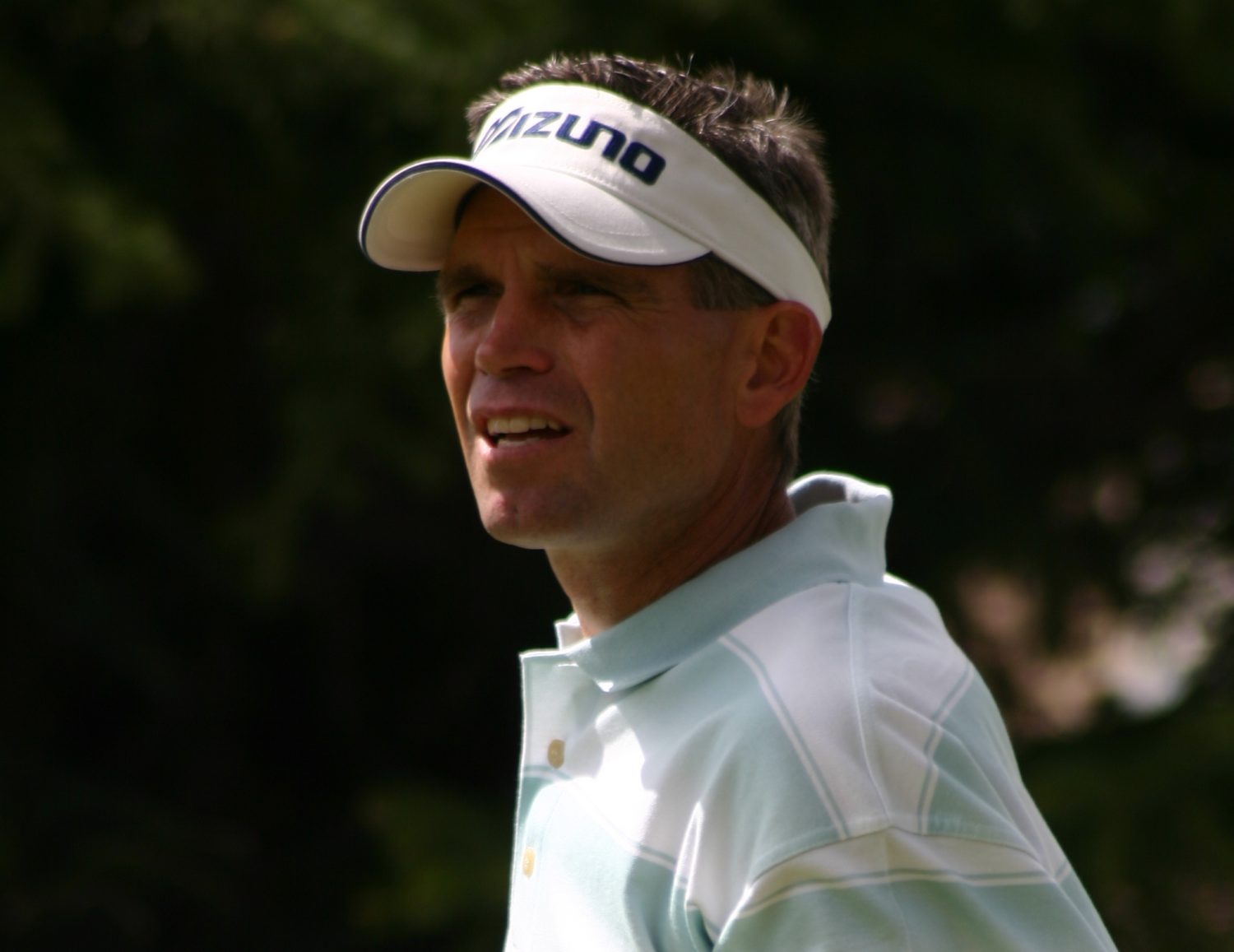
In one of the more poignant scenes of a State Amateur awards presentation, Doug Bybee’s voice caught in 1990 as he referenced two previous losses in final matches and managed to say, “Third time’s the charm, I guess.”
Six years later, his “third time” phrase took on a whole new meaning. Bybee became the storied tournament’s first three-time winner in 37 years, joining Utah Golf Hall of Fame member Lou North. And it keeps getting better: After more than another quarter-century, nobody has matched Bybee’s achievement.
Fair to say, Bybee has been more closely associated with State Amateur match-play success than any golfer since six-time champion Billy Korns in the 1940s (two of North’s wins came in stroke play). His record of 43 matches played was topped only by Dan Horner in 2023; with 33 wins, Bybee and Horner trail only Korns (37).
“There’s only one guy that leaves the State Am happy,” Bybee said. “That’s the cool thing that makes it even better. It’s always better when it’s something that’s really important to you. It’s even harder to win.”
The expression “Par ‘em to death” should go on Bybee’s Hall of Fame plaque. “I don’t necessarily strategize that way, it’s just the nature of my game,” Bybee said in the book “100 Years of the Utah State Amateur.”
Yet that phrase also serves to underestimate Bybee’s ability. He once made 14 birdies in two rounds at Bonneville Golf Course before losing in a playoff in the prestigious Salt Lake City Amateur (an event he won twice, while finishing second three times).
An alumnus of Box Elder High School and the University of Utah, Bybee grew up around the old Brigham Willows Golf Course in Brigham City, although the policy in those days didn’t allow him to play the course until he was 10. He caddied for his father, Ray. Once he started playing, he caught on quickly.
After his consecutive State Am finals appearances in the early 1980s, Bybee spent five years as a professional golfer before regaining his amateur status and working as a successful marketing executive in the food and golf industries.
Bybee remembers becoming aware of the State Amateur only in 1976, when Brigham City legend Reid Goodliffe beat Jimmy Blair in the final match. Vinny McGuire of the old University of Utah GC would become one of Bybee’s big influences. In Brigham City, Goodliffe was Bybee’s friend and mentor, teaching him both the value of pars in match play and the meaning of the State Am.
That’s why Bybee’s losses to fellow Hall of Fame members Eric Hogg in ‘81 and Steve Schneiter in ‘82 were tough to absorb. And it certainly entered his mind in ‘90 that he could become a three-time runner-up, before he defeated Spence Ahrend at Alpine Country Club.
The next year, he knocked in an 85-yard shot for an eagle on the first extra hole at Jeremy Ranch in a semifinal match vs. Ahrend, before topping Brett Taylor in the finals. In 1996 at Hobble Creek Golf Course, Bybee bookended his match-play week with victories over home-course players Doug Baxter and Robert Shunn, winning the last 36-hole match 10 and 9.
Also in ‘96, Bybee received the Utah Section PGA’s Wesley Ruff Golf Citizen of the Year award for the way he represented the Utah golf community.
GAREY CHADWICK
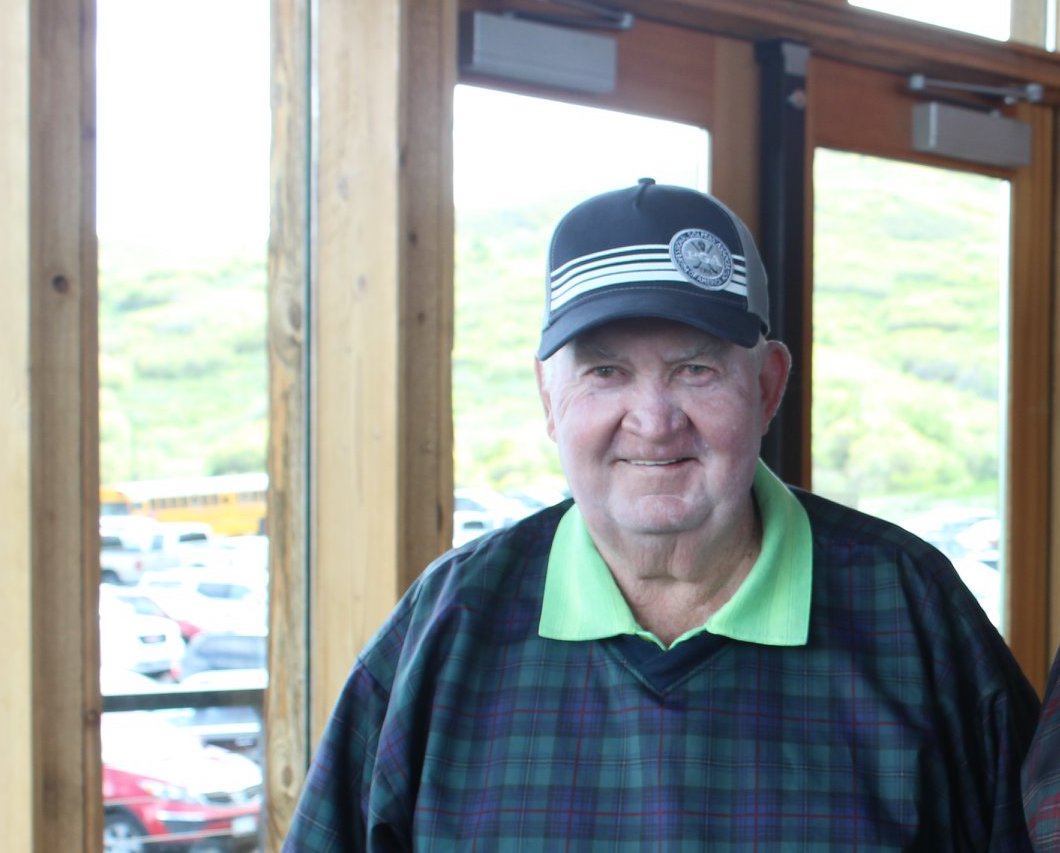
Ron Hitchcock long ago told a great story in presenting the Utah Golf Association’s annual Gold Club Award to Garey Chadwick. As a rising UGA player, Hitchcock once was amazed that Chadwick knew his name.
“It wasn’t until later that I realized Chadwick knew everyone’s first name,” Hitchcock said.
The irony of that story is some people are probably just learning Chadwick’s first name, via his Utah Golf Hall of Fame selection. Seemingly everybody knew him as “Chad,” the friendly administrator and rules official who’s “recognized as one of the good guys in golf,” as Hitchcock said.
Chadwick, who died in 2018 at age 80, forever will be linked to Sherm Hatfield in the Utah golf community. They were the co-honorees of the 2017 Utah Senior Open, shared the Utah Section PGA’s Presidential Service Award in 2014 and will join each other in the Utah Golf Hall of Fame’s Class of 2024.
Summarizing his father’s devotion to the game, Doug Chadwick said, “I know he loved doing it.”
Jake Miller, a former UGA Executive Director, always tried to pair new rules officials with Chadwick “because of his demeanor,” Miller said, likening his approach to that of Utah Golf Hall of Fame member Doug Vilven’s. “He was there to make players feel comfortable. He would take the lawyer-speak out of the rulebook and take it down to the player’s level.”
Chadwick’s 1995 Gold Club Award and 2018 UGA Volunteer of the Year recognition help illustrate his long span of contributions. So do Devin Dehlin remembering Chadwick as the captain of his Utah team in the 1984 Junior America’s Cup, and Bruce and Carolyn Summerhays once crediting him as “a friend and mentor for as long as we can remember … We always teased him that he helped raise our children.”
A former Ogden Golf & Country Club caddie and Weber High School baseball player, Chadwick bought his first set of golf clubs shortly after marrying his wife, Elaine, in 1958. She willingly shared him with the golf community, amid his work in architectural building supply. Chadwick spent 12 years on the UGA board, led junior traveling teams for a decade, served as the Utah Junior Golf Association president and was a U.S. Public Links committee member for 19 years. One of the UJGA’s age-group Player of the Year awards carries his name.
Service to golf was “pretty much his whole life, for sure,” Doug Chadwick said. “It kept him going and actually allowed my mom to participate too. Even when he quit playing golf, kept being involved in tournaments. … Even when I go somewhere to play golf, they bring his name up.”
Chadwick was a traditionalist. During an interview for the 2017 Utah Senior Open, Chadwick listed some of his favorite all-time elements of golf equipment: “wood woods, none of this metal stuff … steel shafts … wound balls.”
Those are long gone, but the way he treated people will have a lasting impact. UGA stalwarts such as Chadwick are “the real Hall of Fame guys, because they’re in the trenches,” said 2024 classmate Bruce Brockbank.
RANDY DODSON

Randy Dodson followed Joe Watts in Utah golf magazine publishing, so it is appropriate that Dodson is in the Utah Golf Hall of Fame class that comes after Watts’ group.
As owner and publisher, Dodson produces Fairways Magazine, designed as a quarterly celebration of Utah golf. As former State Amateur champion Dan Horner likes to say, “Fairways makes players feel more important than they actually are.”
The printed magazine itself is a well-designed marvel in this era; Dodson also has successfully expanded to daily, weekly and monthly digital products.. Beyond that, Dodson has become a major voice of Utah golf through his business arrangements with the UGA, the Utah Section PGA, professional tournaments such as the LPGA Epson Tour’s Copper Rock Championship and other groups via Fairways Media’s public relations work.
“I’m extremely happy that we’ve been relevant for over three decades,” Dodson said, crediting former associate Mike Stansfield and current Art Director Garrit Johnson, in addition to loyal advertisers.
Johnson salvaged records and other valuable items, helping Dodson overcome a 2019 fire that destroyed the former Fairways office in downtown Provo. That’s just one example of the team’s adaptability in a changing media world.
Fairways’ impact goes beyond words and pictures, though. The Utah golf community is nationally known for cooperation among various groups, and Dodson is among the unifying forces. “I felt like Fairways could help in that process,” he said. “Fairways could be the middle ground for everybody. … We always wanted to be a cheerleader for Utah golf, how ever that’s defined. I think we’ve done a good job of making sure Fairways is not just a UGA newsletter, but a Utah golf lifestyle publication.”
The strongest endorsement once came from Watts, the UGA’s longtime Executive Director: “The UGA would be invisible without Fairways,” said Watts, who described the magazine as “the UGA’s greatest achievement.”
Devin Dehlin, the Utah Section PGA’s Executive Director, labeled Dodson “very instrumental in the success and growth of golf in Utah.”
Watts and Dodson were driving forces of the book “100 Years of the Utah State Amateur.”
Dodson received the UGA’s Gold Club Award in 2014 and is a two-time winner of the Utah Section PGA’s Wesley Ruff Golf Citizen of the Year award. Dodson and Watts are among only six people who have earned both awards.
Dodson previously worked in advertising for newspapers in California, Massachusetts and Utah The transition to Fairways was not a direct handoff from Watts, although they share a strong connection. Dodson had started working for Peter Evans’ Utah Business magazine and, when Evans decided to sell the golf publication, Dodson and his wife, Tonia, took the leap.
Dodson had to “get myself entrenched in the golf world,” he said, while being influenced by the likes of Karl Tucker, Jeannie Goddard and Watts, all members of the Utah Golf Hall of Fame. He learned a lot from “people that see the importance of everybody getting along,” Dodson said. “I think I learned what what I’m supposed to learn, if I’m in that same group.”
SHERM HATFIELD
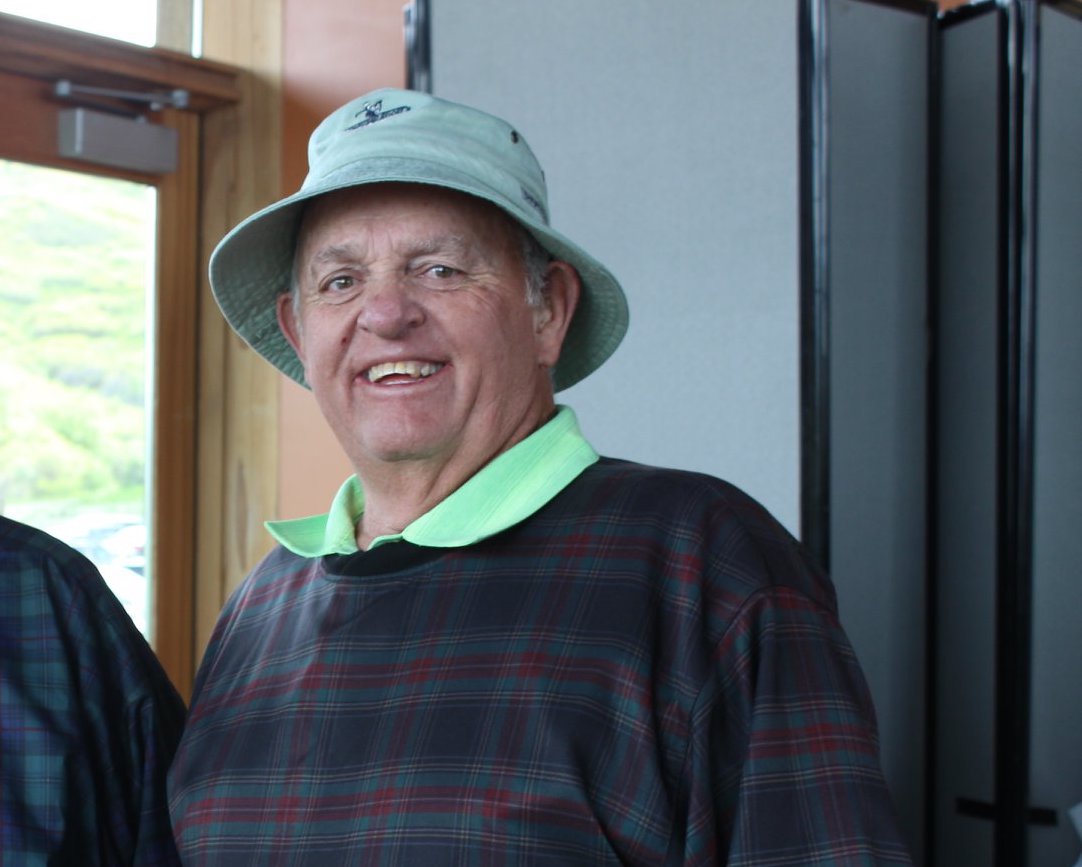
Sherm Hatfield’s road to the Utah Golf Hall of Fame was coated with ice. As a longtime season-ticket holder of the pro hockey team then called the Salt Lake Golden Eagles, Hatfield studied the “Decisions on the Rules of Golf” book between periods of games at the old Salt Palace.
Those 18-minute intermissions eventually led to a lot of 12-hour days on the golf course, serving as a rules official. Even in his late 70s, Hatfield was known for working 50-plus days a year in a volunteer job that he loved mostly because of the people involved.
Hatfield is one of only six individuals to have received both the Wesley Ruff Golf Citizen of the Year award from the Utah Section PGA and the Gold Club Award from the Utah Golf Association.
The other five already are in the Utah Golf Hall of Fame, or should be so honored someday. Friendship and parallel lives of service to the game will always connect Hatfield and Garey Chadwick, yet each has created his own distinction on the way to joining the Class of 2024.
The presentation of Hatfield’s Gold Club Award in 2014 promoted former UGA Executive Director Joe Watts to commend Hatfield’s “unselfish service, his good will, work ethic, compassion for others and his insistence on doing things the right way.”
Hatfield liked to practice “preventive officiating,” making sure players were aware of their options before proceeding. “I enjoyed helping people,” he said. “I’ve been ridiculed for sometimes saving them from doing something that would have caused them a problem.”
It all started when former UGA board member Brent Smith took him to a State Amateur final match at Wolf Creek in 1984. About the same time, he became acquainted with Chadwick, who was working a State Am qualifier at Mountain View Golf Course, where Hatfield was a men’s league leader.
They teamed up on the UGA board (Hatfield was the president in 1994) and as co-captains of Utah’s Junior America’s Cup teams, and have shared awards such as being named co-honorees of the 2017 Utah Senior Open. They were commended that year in a Salt Lake Tribune feature about volunteers in various sports. Bill Walker, then the UGA’s executive director, labeled them “the godfathers of volunteerism,” adding, “Whenever you call, they’re there to help out.”
Having grown up in West Jordan along 2200 West where Mountain View later would be built, Hatfield graduated from Jordan High (well before Steve Schneiter, who was inducted into the Utah Golf Hall of Fame in 2021). He started playing with his father and brothers at Mick Riley GC in the early 1960s after he returned from a military stint in Germany, then worked for Kennecott Copper and Jordan School District while becoming immersed in golf. Hatfield once shot a 68 at Mountain Dell GC, explaining why that number is part of his email address,
That’s not what got him into the Utah Golf Hall of Fame, though. His selection stems from nearly 40 years of contributions to tournament operations for the UGA and the Utah Section PGA. “They just run such good programs, both of them,” he said. “I was having a great time.”
His wife, Joyce, who died in June 2023, was “so supportive,” Hatfield added. “She never complained one iota” about his devotion to the game.
ERIC HOGG
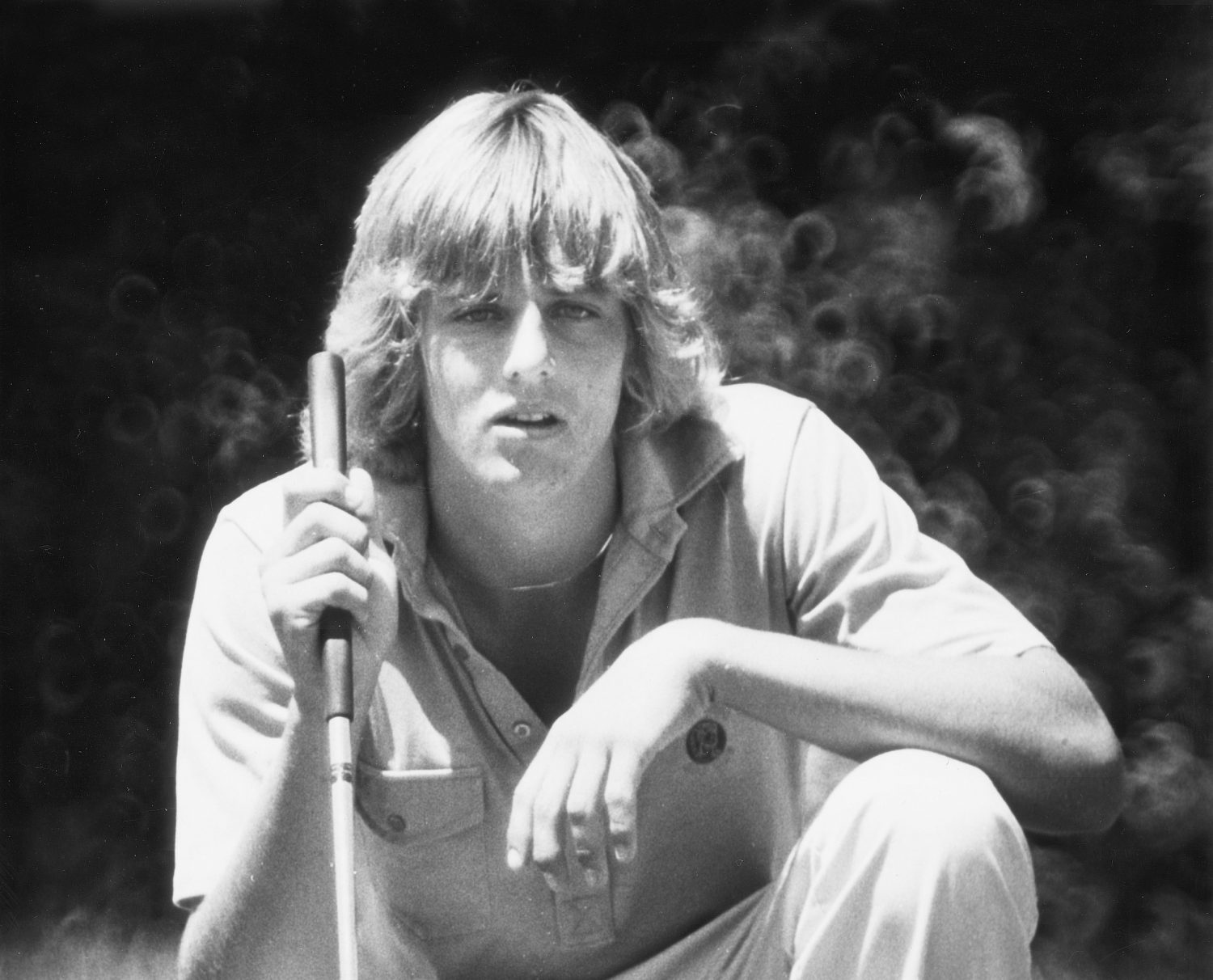
The recent achievements of Mitchell Schow, Blake Tomlinson and Zac Blair in two of Utah’s biggest golf tournaments evoked the name of Eric Hogg. Induction into the Utah Golf Hall of Fame will ensure that Hogg is remembered forever.
Hogg, who died in 2014 at age 51, is among the nine golfers (including Blair) who have won both State Amateur and Utah Open titles. His 1981 State Am victory over Hall of Fame classmate Doug Bybee was the last meeting of University of Utah teammates in a final match until Schow topped Tomlinson in 2020. Hogg also beat Hall of Fame member Arlen Peacock in the ‘81 semifinals; he defeated BYU’s Eddie Heinen in the ‘89 final match.
Hogg’s 1991 rally to overtake Keith Clearwater, then in the prime of his PGA Tour career, came in one of the Utah Open’s most competitive eras as essentially a mini-tour event. It would be another 10 years before another homegrown Utahn (Kim Thompson) claimed the title.
Growing up in Salt Lake City, “Eric always had the support of my parents, don’t get me wrong, but so much of what he achieved was through his own passion and grit,” said his sister, Amy Porter-Nichols. “He would carry two bags of golf clubs, little sister in tow, over a quarter-mile to the city bus stop. We would ride to the course and I would watch him shag and sell golf balls so he could play a round. … He had a passion for golf and immense personal drive.”
Hogg took two individual state championships for a Skyline High School program that created a team dynasty in the late 1970s and early ‘80s. Clark Garso, a high school and college teammate who became a PGA Professional, believes Hogg is one of the top 10 most talented golfers the state has produced, although a freak injury in the final stage of qualifying kept him from ever making the PGA Tour.
Garso cites Hogg’s “exquisite” chipping and putting ability, once demonstrated in a college tournament at The Country Club. Hogg shot 1 under par on the back nine, while hitting only one green in regulation.
“He was so competitive,” Garso said, “and I’m not talking just in golf. There was nobody that wanted to win more than Eric, and I’ve known a lot of great players.”
Bybee remembers his Ute teammate as “way more talented than anybody else … astronomically talented. He could do things that very few people could do.”
Hogg qualified for the 1989 U.S. Open. In the book “100 Years of the Utah State Amateur,” he said, “Playing in the U.S. Open and winning the State Amateur twice are my greatest thrills in golf.”
He also enjoyed the Utah Open victory at Willow Creek Country Club, the site of his State Am win vs. Bybee 10 years earlier. In an era when PGA Tour players with Utah ties often competed in the Utah Open, Clearwater took the two-stroke lead on the front nine of the final round before Hogg caught him. “It was nice to beat him; sure it was,” Hogg said a year later. “He was sure trying to win that tournament.”
That win ended up being the capstone of his golf career. “What a great victory, and it couldn’t have happened to a nicer guy,” wrote Doug Boudreaux, the Utah Open’s media coordinator that year. “He was incredibly humble after the win, and the media ate it up.”
GUY YOCOM

Guy Yocom is in a class by himself in the Utah Golf Hall of Fame. A graduate of Salt Lake City’s West High, the school that also nurtured George Von Elm and Tony Finau, Yocom became distinguished on a national level like no other golf journalist from Utah, writing eight books and earning numerous awards from the Golf Writers Association of America.
For the sake of reference on the Utah Golf Hall of Fame’s all-time roster, consider him the Mike Malaska of the media. Malaska, another Weber State alumnus, grew up in Utah and became nationally renowned as a golf teacher, officially declared a “legend” of his profession by Golf Digest. Yocom’s job description was senior writer, by the end of a 36-year writing career with the magazine. Legend also would be an apt description.
“Utahn” is another label he embraces, leading him to say Utah Golf Hall of Fame membership “means more to me than any other kind of recognition could.”
Known as a skilled, conversational interviewer, Yocom created the “My Shot” feature that became a Golf Digest institution. His ability to go inside the minds of some of the game’s most celebrated figures turned those conversations into treasure troves of memories and insights. Those 125 monthly subjects were “just enormously rewarding” to conceive and develop, Yocom said. “I got to know them as people. They could always trust me, and they knew it.”
You want golf stories? Yocom has a full catalog, and he tells them well. Yet his greatest strengths were developing relationships and making famous people comfortable enough to tell their stories. One career summary said Yocom “interviewed Ben Hogan, won $20 from Phil Mickelson and got a lesson from Moe Norman.”
As an author, he has collaborated with the likes of Tiger Woods, Jackie Burke Jr. and Utah Golf Hall of Fame charter member Johnny Miller.
It all started at the Standard-Examiner in Ogden, where Yocom worked during and after his Weber State tenure with the Signpost school newspaper. In 1981, he watched Hall of Fame classmates Eric Hogg and Doug Bybee play in the State Amateur finals and covered Hall of Fame member Jimmy Blair’s Utah Open victory.
The irony of his golf writing career is that unlike Finau, Yocom never played the game while growing up in Salt Lake City’s Rose Park neighborhood (although he worked on the grounds at Rose Park GC after graduating from West). His dual loves of golf and writing bloomed in Ogden, where his associations with two-time State Amateur winner Mitch Hyer and some Weber State golfers spurred him to become a very good player.
“I just fell in love with golf … just wrote about it all the time.” Yocom said.
So how do you get from the Standard-Examiner to Golf Digest? Talent aside, being “really noisy” and persistent is Yocom’s explanation of his initial hiring. That’s also how he worked his way into writing assignments for the magazine, and he thrived for more than three decades in an environment where “you’re really kind of soaring with eagles,” he said. “I learned so much, and people were so helpful.”
Feature written by Fairways Media senior writer Kurt Kragthorpe.

